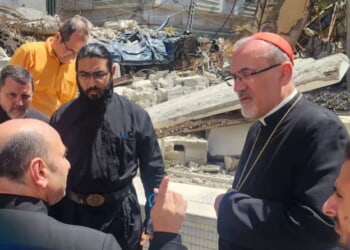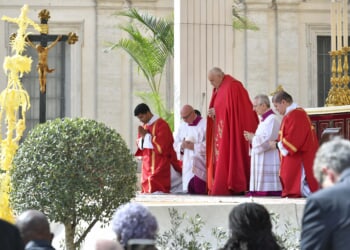Rabbles, Riots and Ruins
By Mike Aquilina
(Ignatius Press, 206 pages, $16)
I think I have by now read ten or so of Mr. Aquilina’s books, and find myself ever putting down his latest with a combination of satisfaction and despair: satisfaction with the impressively high standard of knowledge he brings to his subject, whether it be the history of the Mass or the social teachings of the Church; despair at the recognition that Aquilina can finish a book in roughly the time it takes me to put the final touches on a review like this one.
Mr. Aquilina briefly narrates the transformation of the pagan City on the Seven Hills to the Christian City of the Popes as well or better than anyone.
Certainly someone ought to slow the man down, either by showering him in prizes and honorary degrees or else breaking his fingers.
In his most recent offering, Aquilina undertakes to explore the development of Christian life in the urban culture of the Mediterranean world of late antiquity. It may surprise those who are new to the study of these things that the first Christians were almost exclusively city dwellers, and that the rural landscape of the Roman world remained conservatively bound to the worship of the old gods in many places until the empire was far gone in the course of its ruin.
Quite as late as the early seventh century, Saint Gregory I might be confronted by the sight of Italian peasants making their rustic offerings to Ceres or Faunus in the country districts of the great pope’s lands. A host of authors and scholars have visited this same province of history in recent decades, including the late Rodney Stark in his Rise of Christianity. Even if he makes no mention of this book in his footnotes or bibliography, Mr. Aquilina draws from such a considerable variety of sources, ancient and modern, that we are left with no doubts concerning his capacity as our guide.
The ancient cities on the tour range from the universally known (Rome, Constantinople, Jerusalem) to ones whose names may send the average reader to consult his atlas (Edessa, Ejmiatsin). The pages Aquilina dedicates to the last named place makes up the best chapter in the book. The tale of Armenian Christianity is too little known in the West, and this brief account of its origins makes as good a beginning as any.
That old and honorable nation was in its early days much punished by its geographical position. The Roman to the west and the Persian to the east each had its own designs upon her, and the story of Armenia in the age of the Caesars is one of being used by one empire or the other as a buffer state to shield it against its enemy. The Word of Christ was announced to this much-enduring kingdom by St. Gregory the Illuminator, perhaps an unlikely evangelist, who was the son of the assassin who had murdered Armenia’s King Khosrov the Brave in 258 A.D.
The assassin, for his trouble, was murdered in turn with his entire family, except for the infant Gregory, who was secreted away to Roman Cappadocia where he was raised and received an education at once Christian and Hellenistic. When he had come of age, Gregory returned eastward to the land of his birth where he and other apostles began to preach the faith of the Nazarene in the teeth of a monarchy at first inhospitable to the new Gospel; Gregory was taken prisoner and, on the order of King Tiridates, was cast into a disused well where he was, as the legend tells, kept prisoner for fifteen years.
When finally he was released he won the conversion of the same King who had imprisoned him. The Monastery of Khor Virap now stands on the site of the saint’s confinement. All of these things were accomplished before a single emperor of Rome had received baptism. Whether Europe can live without the Faith once received is a question that cannot be answered in this place. That the Faith can, and has, lived and flourished without Europe and her patronage is surely obvious.
Christian History and 20-Page Segments
Most of this book’s chapters are short — twenty pages or fewer — and necessarily much that is assuredly worth the telling must be left untold. The section on Rome, the Urbs Aeterna, is superficial, with Romulus, Cicero, St. Peter, Theodosius, and Odoacer making their entrances and their exits within the space of a few paragraphs. Mr. Aquilina briefly narrates the transformation of the pagan City on the Seven Hills to the Christian City of the Popes as well or better than anyone under these severe restrictions of length. Still, it makes one wish he had settled into his subject with more leisure and written at least twice as long a book.
Occasionally Mr. Aquilina makes a statement that is less indisputable than he appears to believe. For instance, on page 66 he writes that, following the scapegoating and persecution of the Roman Church by Nero, “it was officially illegal to be a Christian, and the penalty was death.” It is far from certain that the martyrdoms that followed the Great Fire of 64 A.D. were immediately justified ex post facto by official additions to the corpus of criminal law.
In the same chapter, we read that “[The first Christians in Rome] might have been sailors or soldiers or merchants.” The second of these occupations was practically impossible for a Christian of the first century to perform, with the very rarest exceptions such as that of Cornelius the Centurion in the Book of Acts proving the rule. But to hold minor blunders like this against Mr. Aquilina would be wretchedly ungenerous. This is a fine work of journeyman’s history that deserves the attention of many readers besides this one.
READ MORE:





![Jasmine Crockett Justifies Mass Illegal Immigration With Bizarre Argument [WATCH]](https://www.right2024.com/wp-content/uploads/2025/03/1742007023_Jasmine-Crockett-Justifies-Mass-Illegal-Immigration-With-Bizarre-Argument-WATCH-350x250.jpg)

![NYC Tourist Helicopter Falls into Hudson River, Siemens Executive and Family Among Those Killed [WATCH]](https://www.right2024.com/wp-content/uploads/2025/04/NYC-Tourist-Helicopter-Falls-into-Hudson-River-Siemens-Executive-and-350x250.jpg)








